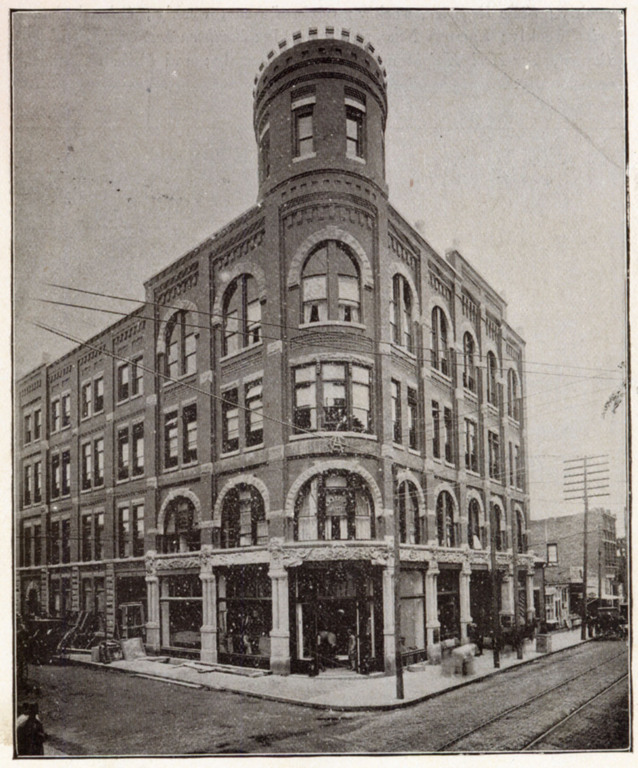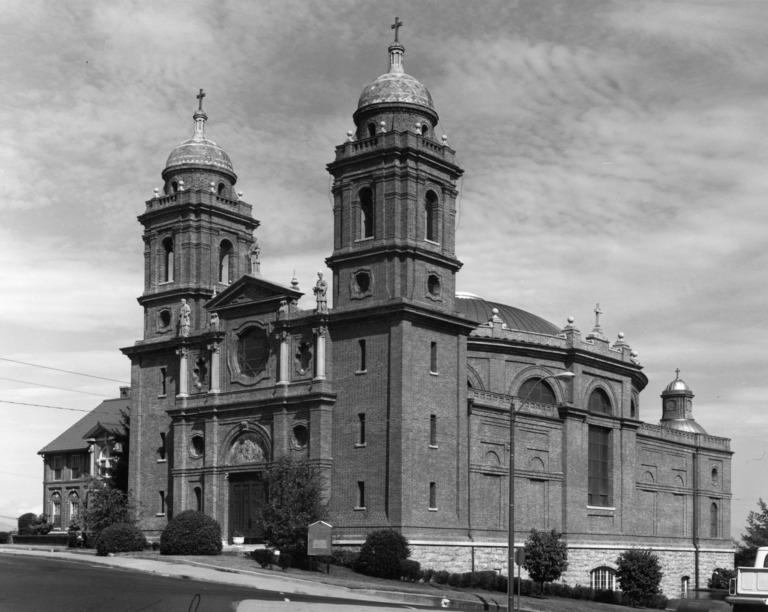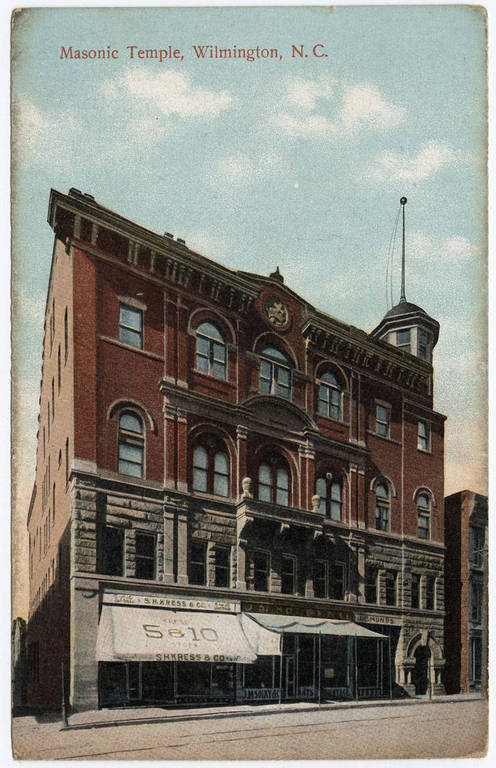Miles, Frederick B. (1860-1921)
Birthplace:
England
Residences:
- Lexington, Kentucky
- Asheville, North Carolina
- Atlanta, Georgia
- Nashville, Tennessee
Trades:
- Sculptor
- Architect
NC Work Locations:
Building Types:
Styles & Forms:
Chateau Style; Romanesque Revival
Frederick B. Miles (December 26, 1860-October 4, 1921), a long-lived and mobile stonecutter and sculptor, is best known in North Carolina for his work at Biltmore House and elsewhere in Asheville. Miles and his fellow stone cutter Samuel I. Bean were among the highly skilled building artisans who came to Asheville to work on George Vanderbilt’s palatial Biltmore estate, several of whom stayed in the city. Although his work at Biltmore is not identified, he is well remembered locally for the fanciful and expertly carved stonework on the landmark Drhumor Building in downtown Asheville, much of which survives in place. He later carved ornamentation for the Basilica of St. Lawrence in Asheville and the Masonic Temple in Wilmington, N. C.
Frederick B. Miles was born in Shaftesbury, Dorset, England and gained his professional training in England. The ninth of ten children, he was a son of master builder Thomas Bullen Miles, who was known for building churches. Frederick worked for his father, apprenticed with sculptor R. A. Stevens of Worcester, and studied sculpting at the School of Art in South Kensington. He married Maud Squinnell in 1884, and they soon began a family. In 1891 Miles was employed as an “architectural carver” and “mason” in London. In 1892 he and his family emigrated from London to the United States, where Frederick would have a productive career as sculptor and stone carver for a series of important New South buildings.
Miles and his family soon settled in Asheville, N. C., where he was employed as a sculptor at the Biltmore Estate, one of many specialized artisans from Europe and northern cities who came to work on the project. He also took on other local architectural commissions including the Drhumor Building in downtown Asheville. The Asheville Citizen of February 28, 1960, described a piece of stone carving which had been removed from the building (then the Wachovia Bank) and was embedded in a wall: “The fragmentary carving depicts a sea goddess with a sailing vessel in the background. It is the work of Fred Miles, an Englishman who came to Asheville in 1891 to work on the Biltmore House.” The article explained that Miles and Samuel I. Bean, “who also came here to work on the mansion, went into business together. According to Carl and Ervin Bean, sons of S.I. Bean, the carving, about two feet high, was part of the Wachovia Bank building before it was remodeled.”
Miles began the Drhumor Building project in November, 1895, to great local approbation. As it neared completion the following June, the Asheville newspaper commented that sculpture was a “recently exemplified art here, because mainly possible as a luxury only to those in the wealthier cities,” and lauded Will Cocke, client for the building and mayor of Asheville, for employing “Sculptor Miles”, whose handiwork on the Drhumor building was much admired by residents and visitors. The same article predicted that Miles’s work was to appear in the A. M. Field Store, “where he promises the finest designs in the South, to be finished in a few days” (Asheville Citizen-Times, November 21, 1895; June 24, 1896).
While in Asheville, Miles was also commissioned to carve grave markers and monuments, including one for a son of Mr. and Mrs. Gaston Mears (1896) and others for Dr. E. Baird and Miss Boyd of Weaverville (1897). In 1897, he submitted two designs in the competition for the Vance Monument to former governor Zebulon Vance in Asheville, and his scale models were displayed locally. (The winning design was by the English-born architect Richard Sharp Smith, who had been supervising architect at Biltmore and continued to practice architecture in Asheville and beyond thereafter.) Also in 1897, Miles began offering a class in modeling and carving at the local school of art, and he partnered with Samuel I. Bean at his Bean’s studio in Asheville. In 1898, he traveled to Augusta, Georgia, where he worked on carvings for the Catholic Church of the Sacred Heart and the Paine Institute for African Americans. In that year, Miles apparently became a naturalized United States citizen while living in Asheville.
About 1899, Miles and his family began a series of moves, first to Lexington, Kentucky, where he worked as a sculptor on the massive, stone Richardsonian Romanesque style Fayette County Courthouse (1898-1900); his role in that project has been rediscovered recently (see Eblen, 2017). The Miles family was recorded as living on West 2nd Street in Lexington in the United States Census of 1900. While in Lexington, in 1899 Miles was commissioned to carve the ornamental sandstone arched entrance for the Masonic Temple (1898-1899) in Wilmington, N. C.
Miles’s tenure in Lexington was brief, and by 1902 he and his family had moved to Atlanta, where he worked as a sculptor for the Atlanta Marble Company and also operated his own office. While in Atlanta, Miles accomplished one of his best known works, the marble ornamentation for the Candler Building (1904-1906), an elaborate Renaissance Revival style skyscraper by architect George E. Murphy. Miles remained in Atlanta until 1911. For a photograph of him and his workshop, see the Atlanta Constitution, November 19, 1905, which also featured a drawing of the elaborately adorned Candler Building, which was when completed in 1906 the tallest skyscraper in Atlanta. During his time in Atlanta, Miles was also commissioned to create a granite statue of an angel for the Basilica of St. Lawrence in Asheville; for a photograph of Miles with the sculpture in 1907, see the Asheville Citizen-Times, May 15, 1955.
Around 1912, Miles and his wife and daughter Connie moved to Nashville, Tennessee, where Miles continued to work as a commercial sculptor and taught night classes at a local art institute. His wife, Maud, died on October 30, 1913, and was buried in Nashville’s fashionable Mt. Olivet Cemetery. In 1917, Miles was employed as a sculptor with W. W. Leland and Company, a New York-based producer of carved granite and marble statuary, monuments, etc., which had branches in various cities; the Nashville branch opened about 1916. As earlier, Miles continued to teach sculpting, including modeling in clay, in Nashville from 1913 to 1918 at the Watkins Institute, a noted center for the arts, and he exhibited his sculpture at the local Carnegie Library (Tennessean, May 10, 1914). Long afflicted with ill health, including arthritis, in 1920 Miles became very ill and paralyzed, moved for a time to Florida to live with a daughter, and then returned to Nashville, where he died after suffering from paralysis for over 14 months. He was buried in Nashville’s Spring Hill Cemetery.
Brought to the American South by the great Biltmore project, Miles left his mark on several of the region’s growing cities in the creation of architectural sculpture of high artistic value that reflected his youthful training in England.
- Catherine W. Bishir, Michael T. Southern, and Jennifer F. Martin, A Guide to the Historic Architecture of Western North Carolina (1999).
- David R. Black, Historic Architectural Resources of Downtown Asheville, North Carolina (1979).
- Tom Eblen, “As elaborate stone carvings emerged on old courthouse, so did a mystery,” Lexington [KY] Herald-Leader, January 26, 2017.
- “Fred B. Miles, Sculptor,” Asheville Citizen-Times, May 15, 1955.
- “A Genius of the Chisel,” Asheville Citizen-Times, June 24, 1896.
- Robbie D. Jones, “Frederick Bullen Miles (1860-1921), Sculptor,” digital manuscript, 2017.
- Janet K. Seapker, “St. John’s Masonic Lodge, Part II: Other Masonic Lodges,” Lower Cape Fear Historical Society Bulleting, Vol. L, No. 2 (April 2006).
Basilica of St. Lawrence
Contributors:Samuel I. Bean, stonemason; Rafael Guastavino, Sr., architect; Frederick B. Miles, sculptor; Richard Sharp Smith, architect; Rafael Guastavino, Jr., architect and builderVariant Name(s):St. Lawrence Catholic Church
Dates:1905-1909
Location:Asheville, Buncombe CountyStreet Address:97 Haywood St., Asheville, NC
Status:Standing
Type:Religious
Images Published In:Catherine W. Bishir, North Carolina Architecture (1990).
Catherine W. Bishir, Michael T. Southern, and Jennifer F. Martin, A Guide to the Historic Architecture of Western North Carolina (1999).
David R. Black, Historic Architectural Resources of Downtown Asheville, North Carolina (1979).
Douglas Swaim, ed., Cabins and Castles: The History and Architecture of Buncombe County, North Carolina (1981).Note:Famed Spanish architect-builder Guastavino and Smith worked together on the imposing brick church, where the broad dome and other elements show Guastavino’s unique self-supporting tile construction and other tilework, which he manufactured at his estate near Black Mountain. Guastavino is entombed in the church. Drawings survive in the Richard Sharp Smith Drawing Collection, Asheville Art Museum, Asheville, North Carolina. See http://d.lib.ncsu.edu/collections/catalog?utf8=%E2%9C%93&f[classification_facet]=Richard+Sharp+Smith+Collection&q=St.+Lawrence.
Frederick B. Miles, who like Guastavino and Smith, had come to Asheville to work on Biltmore, was commissioned to carve a stone angel for the basilica. The church was elevated to the status of a basilica in 1993. Rafael Guastavino, Jr., completed the edifice after his father’s death.
Drhumor Building
Contributors:Samuel I. Bean, stonecutter; A. L. Melton, architect; Frederick B. Miles, sculptor; J. M. Westall, builderDates:1895-1896
Location:Asheville, Buncombe CountyStreet Address:Patton Ave. at Church St., Asheville, NC
Status:Standing
Type:Commercial
Images Published In:Catherine W. Bishir, North Carolina Architecture (1990).
Catherine W. Bishir, Michael T. Southern, and Jennifer F. Martin, A Guide to the Historic Architecture of Western North Carolina (1999).Note:See Asheville Citizen-Times, November 21, 1895; June 24, 1896. The building originally had a tower atop the corner bay. That feature was removed in the 20th century, and the entrance was shifted to Patton Avenue and given a large arched frame. Frederick B. Miles’s splendid stone carving reportedly included visages of local citizens as well as mythological and classical motifs. The building is one of the principal surviving examples of downtown Asheville’s late 19th century growth era.
Masonic Temple
Contributors:David Getaz, contractor; David Getaz Company, contractors; Joseph F. Leitner, architect (1914); Charles McMillen, architect (1898-1899); Frederick B. Miles, sculptorDates:1898-1899; 1914 [remodeled]
Location:Wilmington, New Hanover CountyStreet Address:25 N. Front St., Wilmington, NC
Status:Standing
Type:Fraternal
Images Published In:Tony P. Wrenn, Wilmington, North Carolina: An Architectural and Historical Portrait (1984).
Note:Wilmington architect-builder James F. Post submitted an earlier design for the Masonic Temple, but the Masons chose the design by the Minnesota architect McMillen, who specialized in Masonic temples. This commission brought McMillen to Wilmington, where he settled down to practice his profession. The cornerstone was laid on May 18, 1899, and the building opened on November 20. The 4-story edifice of pressed brick and brownstone had stores on the first floor, offices on the second floor, the Masonic lodge halls on the third floor, and a ballroom on the fourth floor. Frederick B. Miles executed the carved ornament of the entrance. In January, 1914, the Scottish Rite Masons leased the ballroom from the central body and expended $4000 to create a theater, complete with stage, designed by Joseph F. Leitner. For more details, see Janet K. Seapker, “St. John’s Masonic Lodge, Part II: Other Masonic Lodges,” Lower Cape Fear Historical Society Bulletin, Vol. L, No. 2, April 2006; and Tony P. Wrenn, Wilmington, North Carolina: An Architectural and Historical Portrait (1984).



